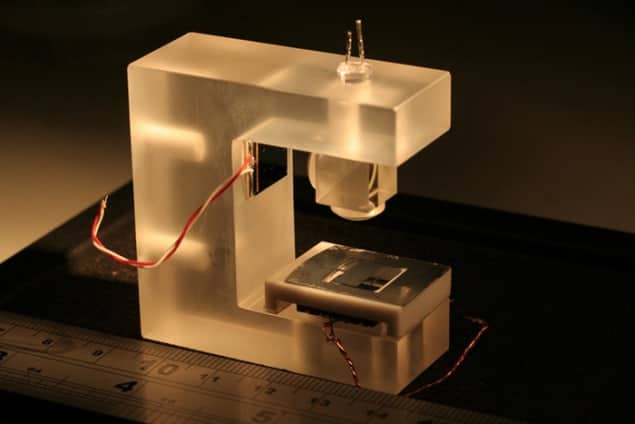
A tiny device that can make very precise measurements of the Earth’s gravity has been unveiled by physicists at the University of Glasgow in the UK. While their gravimeter is not quite as sensitive as the best available sensors, the team says that it could be produced for a 1000th of the cost. It is also significantly smaller and lighter than current devices, and could be deployed in drone aircraft or in multi-sensor arrays to perform a range of tasks, including mineral exploration, civil engineering and monitoring volcanoes.
Gravimeters are sensors that measure the local acceleration due to the Earth’s gravity. Today, the smallest high-precision devices weigh several kilograms and are the size of a loaf of bread. They have found use in a wide range of applications, from mineral exploration – detecting changes in local gravity caused by mineral deposits – to civil engineering, where they can be used to detect voids under roads or railway tracks. They can also be used to detect magma movements deep underground, which often happen before volcanic eruptions.
Most commercial gravimeters work by making a very precise measurement of the position of a mass that is pulling down on a spring. A measurement is made with the gravimeter in a location of interest and then compared with a separate measurement made at a reference location. Doing this reveals the difference in local gravity between the two locations to a precision of about 10–8 m s–2. While other devices are available for measuring gravity – including quantum gravimeters – all options tend to be cumbersome and difficult to use. Furthermore, they are very expensive, with a typical price tag being in excess of $100,000.
Smartphone inspired
Now, Giles Hammond and colleagues at the University of Glasgow have built a gravimeter that could offer a simple, compact and low-cost way of measuring gravity. The chip uses a microelectromechanical system (MEMS) that is similar to that used in accelerometers, which are ubiquitous in smartphones. However, the new device is about 1000 times more sensitive to accelerations than the devices found in consumer electronics.
The gravimeter is based on a “proof mass”, which is a piece of silicon about 10 mm long that sits on top of two flexible struts – much like a vehicle sitting on top of a leaf-spring suspension. The mass, struts and frame are all made from a single 200 μm-thick silicon wafer using standard semiconductor-manufacturing processes.
Gravity pulls the mass down while the struts push it up, leaving it in an equilibrium position that is defined by three quantities: its mass, the spring constant of the struts and the acceleration due to gravity (g). The spring constant and the mass are fixed values, and therefore any change in the position of the silicon is a result of a change in the local value of g.
Tiny changes
The position of the mass is measured by using an LED to shine light onto the mass, casting a shadow on a detector behind the mass. The optics are set up so that tiny changes in the position of the mass are detected as changes in the amount of light reaching the detector.
While silicon is a very convenient material to manufacture, it will expand and contract significantly with changes in temperature. To get around this problem, the team used a heater and a very precise thermostat to maintain the temperature of the sensor to within 1 mK.
To test the gravimeter, the device was set running for several days to measure Earth tides. This is the tiny oscillation in the strength of the gravitational field caused by the distortion of the shape of the Earth by the tug of the Moon. Sure enough, the gravimeter data showed a clear oscillation with a period of about 12 h that matched what is expected from the Earth tides.
The device has a sensitivity that is about ten times worse than the best commercial devices. According to the team, the device is still sensitive enough to detect a tunnel of cross-sectional area 2 m2 at a depth of 2 m, and could be used to find an oil reservoir with a volume of 50 m3 at a depth of 150 m.
Quantum technologies
Hammond told physicsworld.com that the team is now working with a geological-survey company to develop a portable gravimeter that can be tested in the field. While the current design only measures acceleration in one direction, the physicists plan to create a device that works in 3D. Hammond also says that the team is working on improving the method for measuring the position of the proof mass, which uses technologies developed by the UK’s QuantIC programme for developing quantum imaging technologies.
The gravimeter is described in Nature.



